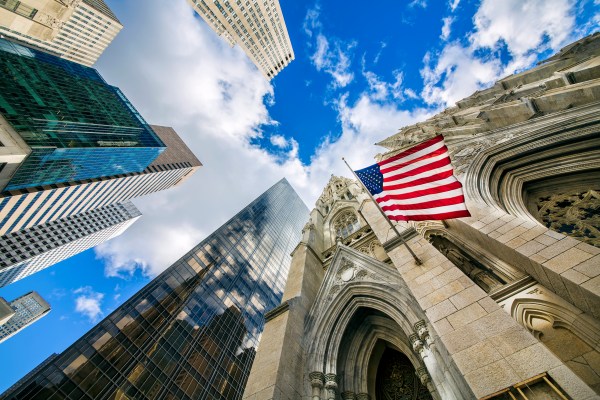Many conservatives and libertarians today lament the rise of “wokeness,” even to the point of believing it to be the greatest political danger facing America. Some of these fears are well-taken.
But concerns about wokeness have distracted many on the center-right from a more serious danger, one far more likely to gain widespread support and cause great harm: nationalism. Terrible woke ideas should be criticized. However, their impact is limited by the smaller numbers of their proponents. Nationalists are far more numerous. And if nationalists acquire the power they seek, they would implement an agenda that does great harm to the lives, freedom, and well-being of millions of people.
Wokeness should neither be neglected nor treated as harmless. But when comparing the two, the nationalist threat should take priority. It’s long past time for right-leaning critics of both ideologies to treat nationalism for what it is: the greatest threat to liberal democratic institutions today.
“Nationalism” and “wokeness” are relatively vague terms with multiple meanings, so it’s important to define them from the outset.
Nationalists believe the main purpose of government is to protect the interests of a particular ethnic, racial, or cultural group, usually the majority group within the nation. They generally view foreigners with deep suspicion, support severe restrictions on immigration and international trade, and tend to back large welfare-state programs. Nationalism’s focus on ethnic and cultural particularity distinguishes it from other ideologies that promote patriotism on universalistic grounds, such as the idea that U.S. institutions deserve loyalty because they promote universal values of liberty and democracy.
“Wokeists” hold that the U.S. and other Western nations are deeply compromised by a history of injustice toward “historically marginalized groups.” When it comes to race, for example, they treat this “structural racism” as almost ineradicable. To combat these injustices, wokeists advocate for state-based racial and ethnic preferences, sometimes even including reparations. As wokeist icon Ibram X. Kendi puts it, “The only remedy to past discrimination is present discrimination. The only remedy to present discrimination is future discrimination.” Wokeists also push for extensive “antiracist” indoctrination and—in many cases—suppression of what they see as racist and bigoted speech.
For all their mutual hostility, right-wing nationalists and left-wing wokeists actually have much in common. Both groups treat racial and ethnic identity as fundamental and largely immutable. Both want the government to actively promote the interests of some ethnic or cultural groups relative to others. And most of all, both assume a zero-sum world where gains for one group can only come at the expense of others.
But though wokeists and nationalists engage in a similar identity politics, the latter are far more dangerous. Why? In large part, because an identity politics movement promoting the supposed interests of the ethnic majority has a much greater chance of political success in a democratic society than one focused on minority groups. The core potential political constituency for nationalism in the U.S. is white Christians, a group that constitutes a plurality of the population. Many secular whites are also a potential constituency, which is notable since nonreligious members of the ethnic majority have been an important base for nationalist movements in Europe. By contrast, the potential constituency for wokeism—racial minorities and left-wing intellectuals—is far smaller. While people like Elon Musk may fear the “woke mind virus,” many more are susceptible to the nationalist mind virus.
Moreover, most woke policies are highly unpopular. Racial preferences in education, for example, are opposed by over two-thirds of Americans, including most racial minorities. Among women, most oppose woke policies like allowing transgender women to participate in women’s sports or use women’s bathrooms. Wokeists also have a knack for antagonizing members of groups they seek to woo, like insisting on using the term “Latinx,” even though most Hispanics dislike it.
To be sure, woke ideology disproportionately appeals to the highly educated, which gives wokeists an edge in the media, academia, and various bureaucratic institutions. However, nationalists have enough highly educated personnel of their own to counter. TV networks like Fox News and “national conservative” think tanks like The Heritage Foundation (which is planning a wide-ranging nationalist agenda for Trump’s possible second term) provide nationalists with enough media influence and brainpower to get by. Wokeist influence over regulatory bureaucracies is counterbalanced by greater nationalist influence over law enforcement entities—the government agencies with the greatest power to arrest and detain people—and their potential to once again control the White House, which has great leverage over federal regulatory agencies.
History also shows nationalist movements are a menace to liberal political institutions. Whether in 1930s Germany or present-day Russia, nationalist movements have subverted liberal democracy and installed brutal dictatorships in its place. By contrast, not a single wokeist egalitarian movement has achieved such a result. Racial and ethnic minorities have sometimes managed to impose dictatorships over an ethnic majority (as in apartheid-era South Africa). But in those cases, the minority group relied on military and organizational superiority, not on something like a woke egalitarian ideology. There is no real chance of wokeists achieving such military superiority in the U.S. or any other Western nation.
Wokeists have recently suffered setbacks even where their influence is greatest. Nowhere is the power of wokeists greater than in universities, where they are heavily represented among administrators and faculty. Yet numerous leading universities have recently brought back mandatory use of standardized tests in admissions and dropped the use of DEI statements in faculty hiring, two measures long supported by wokeists. Perhaps most visibly, many schools called in law enforcement to crack down on pro-Hamas protesters who had established “encampments” or occupied buildings near end of the academic year. While schools should have taken these steps sooner, the fact so many did so at all is an indication of the limits of wokeist influence.
There is little doubt that nationalists have far greater political influence than wokeists. Nationalists have become the dominant faction of the Republican Party, with Donald Trump openly declaring himself a nationalist. By contrast, committed wokeists are just one of several groups contending for dominance among Democrats. The nationalists, therefore, have a greater chance of leading a political coalition and enacting a more expansive and harmful agenda.
Severe immigration restrictions are at the heart of it—and not just cutting illegal immigration, but the legal kind as well. In his first term, Trump cut the latter far more than the former, and he and his “national conservative” allies would do more in a second term. They plan to gut most types of legal migration, including for family reunification, economic migrants, and refugees—such as Ukrainians fleeing Vladimir Putin’s war of aggression under the highly successful Uniting for Ukraine private sponsorship program—among others.
Nationalists usually paint these policies as beneficial for native-born Americans, ignoring evidence to the contrary. Immigration restrictions deprive Americans of numerous valuable economic and social interactions with migrants, undermining natives’ economic liberty more than any other government policy. Moreover, immigrants contribute disproportionately to entrepreneurship and scientific innovation that benefits everyone. Mass deportations supported by Trump and other nationalists predictably raise prices, severely damage the U.S. economy, and destroy more jobs for native-born Americans than they create. Immigration restrictions also threaten natives’ civil liberties, because thousands of U.S. citizens get swept up in the racial profiling, detention, and deportation that are unavoidable aspects of aggressive immigration enforcement. Nationalist restrictions on legal migration would also predictably exacerbate disorder at the border, as desperate migrants would have no option other than illegal entry. By contrast, expanding legal options is the best way to reduce illegal entry.
There is also a deep moral problem at the heart of immigration restrictions. Libertarians and conservatives rightly oppose woke racial preferences in education and employment because they disadvantage people based on morally arbitrary circumstances of birth. Yet immigration restrictions are much the same: They bar people from living and working in the U.S. because of accidents of parentage and birth. Being born south of the Rio Grande River as opposed to north of it—like being born black instead of white—is a morally arbitrary circumstance outside of people’s control. It should not determine how much freedom and opportunity they have. Indeed, Alex Nowrasteh, an immigration analyst at the Cato Institute, has rightly characterized these immigration restrictions as a form of affirmative action for natives. And it’s a far more severe type of discrimination than woke racial preferences: Being consigned to a lifetime of poverty and oppression in Cuba or Venezuela is far worse than being rejected from an elite university for similar reasons.
The nationalist trade agenda is also enormously harmful. Trump promises to impose 10 percent tariffs on all imports, which would severely damage the U.S. economy, exacerbate inflation, and raise prices for a wide range of goods. The American Action Forum estimates that, after accounting for retaliation by trading partners, it would cost Americans some $123 billion per year. Such a trade war would weaken U.S. credibility abroad and alienate our allies. China, Russia, and other U.S. adversaries would benefit. Additionally, nationalist legislators like Sens. J.D. Vance and Josh Hawley have portrayed industrial policy as a bulwark for the working class—yet they ignore how it rewards poorly performing firms and can be used to support the party in power and punish opponents. And of course, nationalist industrial planning shares many of the flaws of its socialist counterpart.
Nationalists’ fear of cultural change lead them to favor government control of the culture, as well as the economy. Thus, they try to impose speech restrictions on things like drag shows and DEI workplace trainings. Even those who are not fans of such programs should be concerned about the threat to free speech.
Perhaps worst of all, the growth of nationalism poses a severe threat to democratic institutions. Historically, nationalist movements tend toward leader-worship and often degenerate into authoritarianism. The belief that they and they alone represent the true people—the “real Americans,” as opposed to minorities or “globalist” elites—often leads nationalists to reject the legitimacy of election results that go against them. Donald Trump’s effort to overturn the 2020 election based on claims it was rigged against him—by a combination of illegal immigrants and nefarious elites, no less—was in part the product of his personal flaws and idiosyncrasies. But it was also part of a broader tendency of nationalist thinking. A second Trump administration, or a future president influenced by nationalist ideology, might well take more systematic steps to curb free electoral competition. By fiat alone, he could upend not only consequential policies like trade and immigration, but even democratic institutions themselves.
The fight against wokeness should not be abandoned, especially in places where it enjoys great influence. Academics should do more to combat racial and ethnic preferences in higher education, for example, and reduce ideological discrimination in faculty hiring. Moreover, it should be noted that wokeists are not the only illiberal force on the left; “Democratic socialism” remains a noteworthy threat.
But despite such caveats, the threat of nationalism is on another level. No woke policy that has any plausible chance of enactment in the foreseeable future is likely to cause as much harm as the nationalist agenda. No plausible woke policy is likely to consign millions of people to a lifetime of poverty and oppression, or to massively damage the U.S. economy. And though they are certainly illiberal, wokeists are also comparatively unlikely to severely damage democratic institutions or keep in power a president who has lost an election anytime soon.
Conservatives and libertarians should oppose the excesses of the woke agenda. But doing so at the expense of countering the greater nationalist threat is a recipe for disaster.









Please note that we at The Dispatch hold ourselves, our work, and our commenters to a higher standard than other places on the internet. We welcome comments that foster genuine debate or discussion—including comments critical of us or our work—but responses that include ad hominem attacks on fellow Dispatch members or are intended to stoke fear and anger may be moderated.
With your membership, you only have the ability to comment on The Morning Dispatch articles. Consider upgrading to join the conversation everywhere.